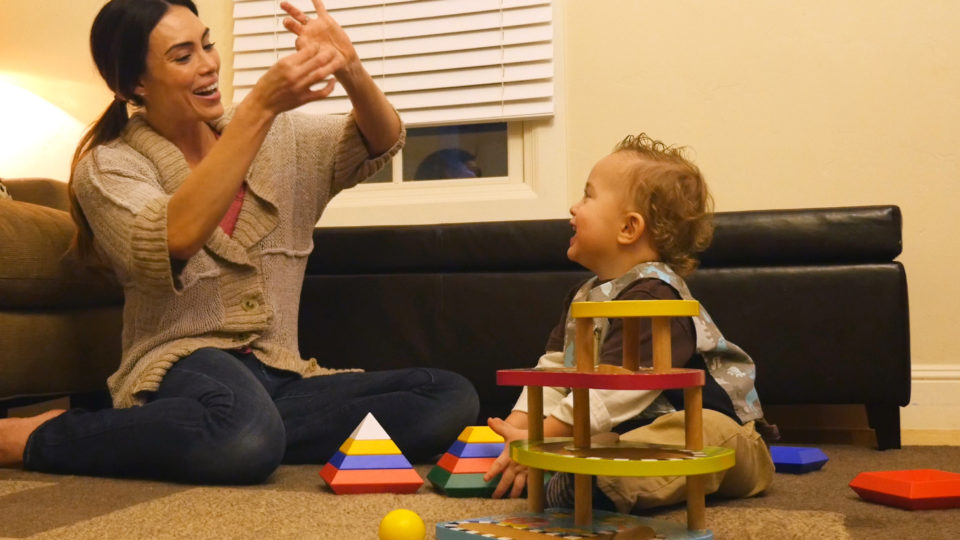Songs and rhymes improve brain development
- October 9, 2017
- / Reggie Dogan
- / studer-community-institute,early-learning

Credit: LENA Research Foundation
“The itsy bitsy spider went up the water spout. Down came the rain and washed the spider out. Up came the sun and dried up all the rain . And the itsy bitsy spider went up the spout again.”
Music is an important part of early childhood education. It plays a role in setting the tone for learning, developing skills and concepts, helping children make transitions and building a sense of commonality and community.
Songs and rhymes have a positive impact on a child’s language and literacy development.
And what’s the most important reason to sing and rhyme with a child? It gives them a love of language. This love of language, of books, of singing and rhyming will form a solid foundation that will help children value learning.
The LENA Start session last week highlighted the benefits of singing songs and saying rhymes with babies.
Using songs, rhymes and fingerplays is a great way to increase words and turns.
“Fingerplays” are songs using small gestures with your hands. They are perfect for getting kids’ attention, especially young babies.
Increasing adult words and conversational turns is driving force behind the LENA Start curriculum, designed to increase communication between parent and child to help build stronger and healthier brains in babies.
The LENA Research Foundation, creator of LENA Start, is dedicated to increasing talk in the first three years of a child’s life when a child’s brain develops to 80 percent of its adult size.
During this critical window, children from low-income families may hear as many as 30 million fewer words than their more affluent peers.
Research shows that the more words children hear in the first three years of life builds the brain structure that will be needed later to support reading and thinking skills. Those early language skills can also lead to continued academic success later in life.
Fifteen parents take part in the Studer Community Institute’s Lena Start class at First Presbyterian Child Discovery Center.
The 13-week session covers an array of topics and activities that offer new ways to increase brain-building talk.
Slides and videos showing techniques, along with take-home materials and a new book each week, are engaging parts of the curriculum that aid in helping parents gain new skills and techniques to talk more with their babies.
LENA stands for Language Environment Analysis. The LENA system measures the way parents and their young children converse.
A digital recorder, or “talk pedometer,” that tucks into a vest worn by babies and toddlers (up to age 3) records a full day’s worth of conversation.
That data is used to generate a report to that provides information on the number of words that the child was exposed to as well as the turn-taking interactions, the back and forth that occurred in the child’s language environment throughout the day.
Songs and rhymes offer a fun and engaging way for parents to increase their communication with their babies and toddlers.
Many of us grew up singing “Itsy Bitsy Spider.” Using songs and rhymes and pictures is a great way to help your child develop their language and communication skills. It’s never too early or too late to start signing and rhyming with your child.
Not only is it fun but it is also a great way to get to know each other. Children’s communication skills develop at different rates but there are many things parents can do to help their child develop.
Encouraging children to sing along and take parts of songs or rhyme are key to building conversational turns.
It is important to take some time every day to sing and rhyme with your child. Make up silly little songs and rhymes as you go along. Use active songs and rhymes during playtime. At bedtime, try a lullaby.
Have fun playing with language. Talk, sing and read with your child. The benefits will stick with them forever.
 CivicCon launches with a look at good growth in cities
CivicCon launches with a look at good growth in cities
 Building stronger brains one baby, one parent at a time
Building stronger brains one baby, one parent at a time
 SCI debuts commercial on Early Learning City
SCI debuts commercial on Early Learning City
 Entrecon: World class speakers and an opportunity to sharpen skills
Entrecon: World class speakers and an opportunity to sharpen skills
 PYP Quality of Life survey 2017
PYP Quality of Life survey 2017
 EntreCon Pensacola 2016: A look back
EntreCon Pensacola 2016: A look back
 Leadership tip: getting better employee takeaways
Leadership tip: getting better employee takeaways
 Leadership tip: be interested instead of interesting
Leadership tip: be interested instead of interesting
 Leadership tip: delivering difficult messages
Leadership tip: delivering difficult messages
 Brain Bags boost Arc, Early Childhood Court programs
Brain Bags boost Arc, Early Childhood Court programs